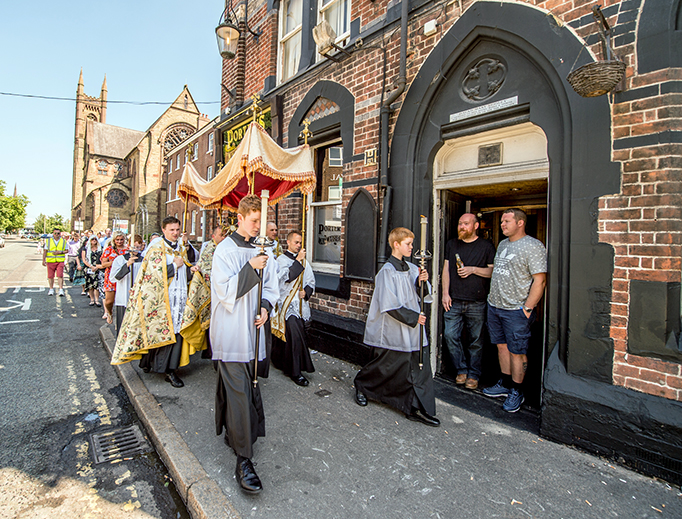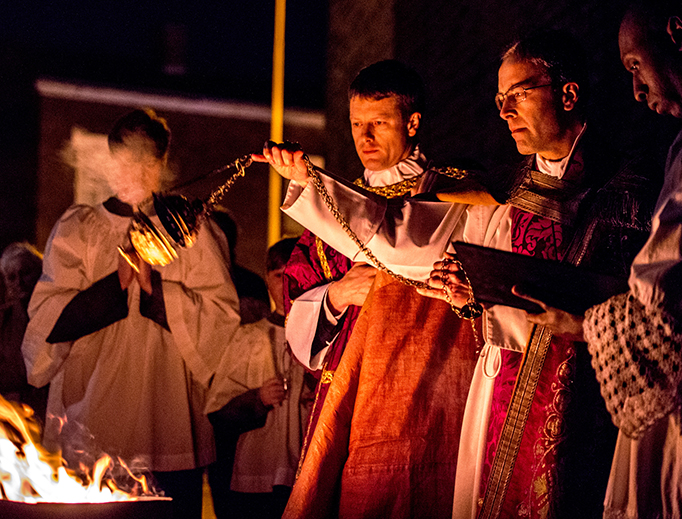FSSP Brings Tradition, and a Spiritual Boost, to Northern England
What is on offer here is a way of life: A Catholic life lived through and in the liturgical year.

In 2012, the Catholic Diocese of Liverpool in the north of England had a dilemma.
The shrine church of St. Mary’s was to be handed back to the diocese by the Benedictine Order, which had served the local people devotedly since the church first opened in 1877. Now the church would have to be sold – used as a store of some sort, a bar, or something worse.
This was no ordinary church, however. Its architect was a Pugin, E.W., son of the famous Augustus. The name Pugin is synonymous with the 19th century Gothic Revival architecture, and, in particular, with the many Catholic churches that were built after the Catholic Emancipation Act was passed in 1829. The fact that the church was a striking example of this architectural movement and also a poignant reminder of the earlier struggles of Catholic forebears in Lancashire made the possible future of the building all the more painful to imagine.
It was around this time that an unusual solution was sought. The Fraternity of St. Peter (FSSP) was born in response to the disobedience of Archbishop Marcel Lefebvre. His decision to start ordaining bishops was met with excommunication. Some priests followed Lefebvre; others stayed with St. Peter and formed the FSSP. Those Catholics who wished to remain loyal to the See of Peter and worship in the classical Roman Rite did so through the ministry offered by FSSP priests, who said Holy Mass according to the 1962 Missal but in full communion with the then-Pope St. John Paul II and, thereafter, with his successors.
The FSSP is a small but impressive presence in England. By 2012, they had one house attached to a church, part of a parish in Reading, where they offered Mass, dispensed the sacraments and preached. As for St. Mary’s, Warrington, it took some years for plans finally to fall into place. In 2015, however, the shrine church of St. Mary’s was handed over to the care of this priestly fraternity. It was a move that caused more than a few eyebrows to rise.
For many, the differences between the Ordinary and Extraordinary Forms of the Mass have been little more than liturgical forms best left to priests and students of liturgy. This is partly because the Extraordinary Form has been so rarely available, and, where it is available, almost always as a supplement to the Ordinary Form within a limited number of parishes. At St. Mary’s, Warrington, there is the rare situation of a church where all the services and sacraments are administered according to the rites and rubrics of the 1962 Missal that most of the congregation did not know and are alien to the majority of those under 50 years old.
The parish church building is, in reality, even more splendid than it looks in photographs. In the British Isles, Catholic cathedrals built after 1829 were relatively small in size; St. Mary’s could easily pass as one. Of course, when one remembers its history, born of the Benedictine mission that had been established in Warrington some decades earlier, it is not surprising that it has the look of an abbey church. Whatever the architectural provenance, there is a longer spiritual lineage present here. Lancashire received the Christian faith in the seventh century. When Henry VIII set up his own church, this northern county retained many Recusant families; later the Catholic population swelled with the influx of Irish at the time of the Industrial Revolution. For many years, therefore, St. Mary’s has been a place of prayer, a place where the Holy Sacrifice is offered, a place of marriages, and baptisms and funerals, for generations of local Catholics. With the coming of the FSSP to Warrington at least this would continue.
The question that had preoccupied me as I traveled north to visit had been different though. How would a congregation who knew little, if anything, about the pre-Vatican II liturgy and rites take to this new dispensation as the parochial norm?
St. Mary’s is served by a number of FSSP priests. The FSSP priest in charge is Fr. Armand de Malleray, as elegant and cultured a Frenchman as he is apostolically energetic. His day starts around 5 a.m., and finishes late each evening. His focus is on the needs of his local parishioners and those who come to worship at St. Mary’s. He is the antithesis of what the secular media would have us believe is the modern priest. He is cheerful, joyful even, in the parish duties that occupy his day. When asked, he tells me how much he loves being a priest. His joy is in carrying out the sacerdotal duties of his priesthood on behalf of the people of Warrington and beyond. He may be as transfixed by the splendor of the Old Rite as any member of the Latin Mass Society, as moved by the singing of the Schola at Sunday Mass as any of the congregation, and as appreciative of the architectural magnificence of St. Mary’s as any aficionado of the Gothic revival, but he is keen to point out that all of these are secondary to why he is there, and, indeed, to why he is a priest, namely, to bring souls to Christ. And many souls, it would seem, have been inspired to come to Christ through him already. In fact, it is clear that in the two years Fr. Armand has been at St. Mary’s he has won the hearts of the parishioners.
Each day at St. Mary’s there is Holy Mass; sometimes an early morning Mass precedes the midday one. Before all weekday Masses and during Sunday Masses the sacrament of Confession is readily available. From what I could see on weekdays, and especially on Sundays, this facility is well used. On Saturday morning prior to midday Mass there are two hours of adoration of the Blessed Sacrament accompanied by the possibility of Confession. In addition, traditional Catholic piety is evident throughout the week: the daily Rosary and the weekly Benediction, to name just two of the devotions. With this is combined the return of the annual Marian and Corpus Christi processions.
The parishioners I spoke to broke down into two groups. There were those who lived locally and had no idea in 2015 what to expect when the FSSP took charge of St. Mary’s; and then there was the other group, those who knew exactly what the FSSP offered and came, sometimes from great distances, to St. Mary’s attracted by that.
The latter group evinced characteristics that might be predicted. They loved the Extraordinary Form of the Mass and all that attaches to it. For them Warrington is one of a number of northern centers where provision has now been made for those who wish to worship under that form while still remaining in full communion with the Church. Their numbers may be small but they make up for this with their ardent dedication and love of the Church.
The more unpredictable and, therefore, to me more interesting group were the parishioners who came unfamiliar with the Extraordinary Form. Expecting some bewilderment at the recent liturgical changes following the arrival of the FSSP I found instead among parishioners a new sense of wonder at the liturgy to which they were exposed. There was more to this wonder than simply a liturgy done well, however. It was the whole pastoral provision that evoked astonishment.
One of the most obvious signs of this was the new regularity with which some of the parishioners came to Mass. Many, now daily communicants, were enthralled by the beauty of the old liturgy, willing to rise for 7 a.m. Mass so as to take part in the Sacrifice in the candle-lit church. These same people had also rediscovered the sacrament of Confession, now made so freely available to all at St. Mary’s, Needless to say, the use of the sacrament has a transforming effect on any faith community; Warrington appeared no different on that point.
In addition, the Sacrament of Confession had resulted in a greater understanding of, and need for, spiritual direction. The weekend following my visit, those who wished were off to a retreat center in north Wales as part of the parish Advent preparation. Parishioners to whom I spoke seemed keen to receive whatever catechetical formation was on offer from the priests who served St. Mary’s. One woman summed up what many had said to me when she stated: “A lot of priests will tell you what you want to hear. The FSSP will tell you the truth.” And by that she meant unvarnished, unadulterated, undiluted Catholic doctrine. Contrary to what is often said or supposed, it appears that many are hungry for this truth.
There were many also looking forward to the liturgical highlights of the forthcoming Advent and Christmas seasons; they spoke as eagerly as football fans anticipating a ‘big game.’ The liturgical calendar is more than simply a set of dates; here at St. Mary’s it is something people live by and through. Some had adjusted their lives radically so as to participate more fully in this liturgical rhythm. One woman had even changed jobs so that she could attend Mass without fail each day at St. Mary’s. None of those questioned had anything but praise for the new arrangements. There appeared to be more than just a new liturgical regime in place.
In the past year, families have moved from London and Wales to live near St. Mary’s. I suspect they will be the first of many. What is on offer here is a way of life: A Catholic life lived through and in the liturgical year. Just a few years back, St. Mary’s almost disappeared. Today, a spiritual resurgence appears to be underway.
In the mid-19th century, Warrington had an art school that produced a number of noteworthy artists. Their work is in evidence at the local museum and art gallery. At the entrance to Warrington Museum is one of the most renowned works of that school: a huge marble statue of St. Michael the Archangel slaying Satan. As I left St. Mary’s for my train back to London I passed the museum entrance. Sounding in my ears was the traditional prayer to St. Michael said at the end of Mass. In his statue of the Archangel, the Warrington artist had created a formidable spectacle of the triumph of good over evil. At the end of the Sacrifice of the Mass, there is an equally clear triumph of good. The Divine Artist presents it not at the entrance of a public gallery, however, but rather at the threshold of eternity where, for a brief moment, we catch a glimpse of the home for which each soul longs.















